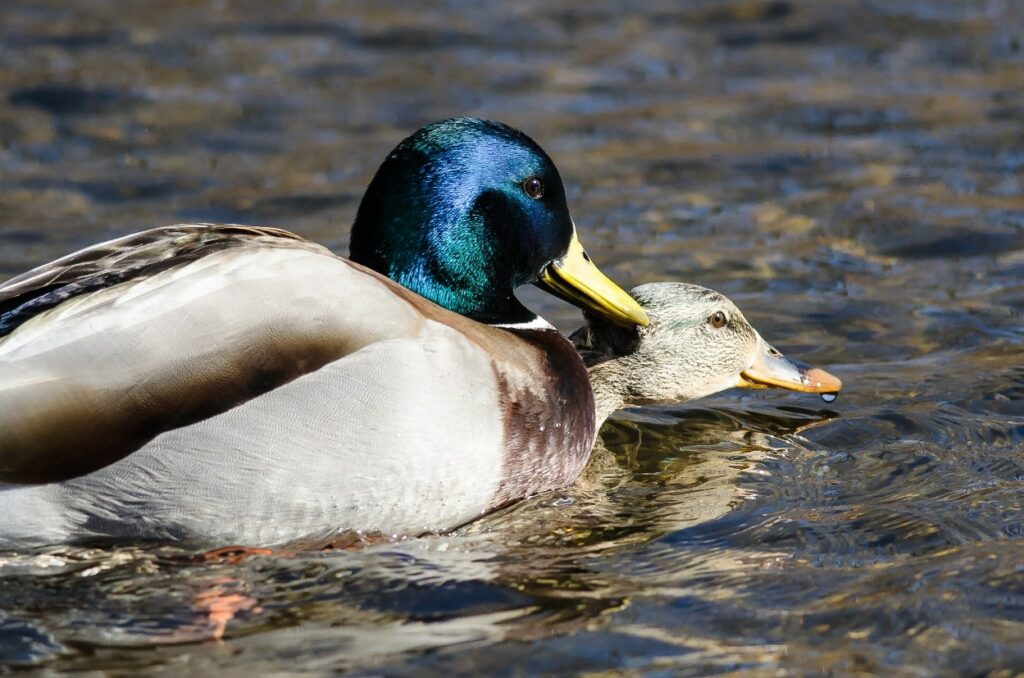Ducks are small water birds that spend their entire lives on or near water, such as ponds, lakes, reservoirs, rivers, wetlands, and floodwaters. They are in the same order as geese and swans (Anseriformes) but are classified in the Anatidae family.
Unlike geese and swans, most ducks do not mate for life. Ducks are monogamous for one season, staying together long enough to produce offspring before migrating at the end of the breeding season. Before the next breeding season begins, they find a new mate.
Ducks are found worldwide, including some sub-Antarctic islands, and in many habitat types. They fill various niches within these habitats.
Dabbling ducks feed on vegetation and invertebrates at the water’s surface and below it, but without completely submerging their bodies.
Diving and sea ducks feed on fish and invertebrates by diving underwater, completely submerging themselves, and swimming after prey.
Do Any Species of Duck Mate for Life?
Most ducks in the Anatidae family are seasonally monogamous, only staying together to mate for one breeding season. However, whistling ducks are the exception to this reproductive strategy. Whistling ducks mate for life.
Whistling ducks are dabblers that live in tropical and subtropical areas of the world. Their call is a distinctive whistle, which is where their name originated.

When Do Ducks Mate?
Male and female ducks pair up at the beginning of the breeding season. Males perform a courtship ritual that involves a series of head and body movements that are species-dependent, including head bobbing and head thrusting.
The reproductive timing and strategies of ducks vary by species.
The Mallard Duck is the most common wild duck species in North America. Mallard females select a mate, then build a nest of grasses, leaves, and twigs near water in thick vegetation to hide it from predators. They lay up to thirteen eggs and incubate them for up to a month.
Most ducks readily nest in nesting boxes or other artificial structures provided by humans. These boxes sometimes offer female ducks a supplemental nesting location in areas where secure nesting habitat is scarce.
How Do Ducks Mate?
Ducks mate in a series of copulatory actions where the male duck jumps on the back of the female. Mating occurs in the water or on land, sometimes resulting in the female drowning because the male is too heavy.
The male duck has a corkscrew-shaped penis, while the female duck has a corkscrew-shaped vagina with some blind ends and other aspects that make copulation difficult.
Because of these genital shapes, successful copulation usually requires cooperation from the female. Female ducks encourage fertilization with their chosen mate by sitting in a receptive posture that allows males to fertilize their eggs.
The reason for this elaborate copulation method is to prevent unchosen, low-quality males from successfully fertilizing eggs and passing on their DNA. Some male ducks aggressively defend their female and nest from invading males to ensure their offspring survive.
How Often Do Ducks Mate?
Ducks only mate one time each year. Depending on the species, mate selection may happen as early as the fall. The mated pairs then overwinter and begin the breeding season together in the early spring. Females choose the most high-quality male from those available.
Many populations tend to have more male ducks than females, so females have plenty of available options. Once she chooses her mate, they produce one brood before the end of the breeding season.
Female ducks are often the victims of repeated forced copulations with one or multiple unmated males during the breeding season. When this occurs, some females resist while others passively allow it but don’t help the males achieve successful fertilization.
Females that resist weigh the cost of allowing a low-quality male to fertilize their eggs over the higher-quality males they originally selected and are determined to fight against it. These females are often injured and sometimes killed while resisting forced copulation.
The females that passively allow it usually already laid their eggs and are trying to protect their brood from being damaged during a fight to resist or to prevent injury or death that would leave their nests vulnerable.

What Happens If a Duck Loses Its Mate?
Ducks do not seem to mourn the loss of their mates. They occasionally lose their mates through abandonment or death. If a female duck loses her mate through abandonment or death after she reaches the egg incubation stage, she will likely continue to raise her brood on her own.
If her mate dies or disappears before she starts incubating eggs, she usually abandons the nest and begins again with a new mate that will fertilize her eggs and provide some protection against other males and predation.
If a male loses his mate, even at the beginning of the nesting season, he will seek a new mate and try to reproduce before the end of the breeding season.
Sometimes, male ducks will abandon their mate during the breeding season if the female ducks are being heavily harassed by unmated males and experiencing frequently forced copulations. When that occurs, the females may also abandon their nests and eggs.
Also Read: Do Geese Mate For Life?
By the time female ducks finish incubating their eggs, the males have already left them to migrate to the locations where they spend weeks during their molt. Females continue to raise the ducklings on their own and molt their own feathers on the breeding grounds during this time.
